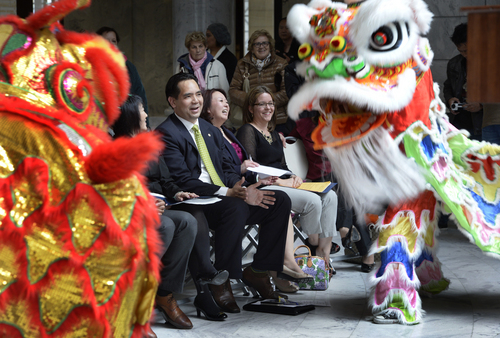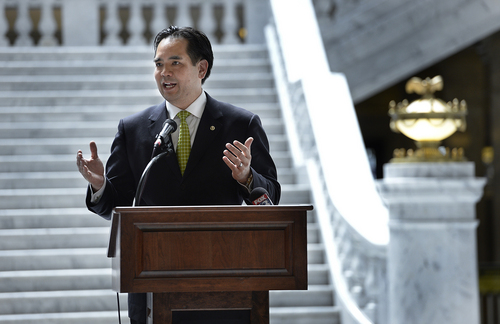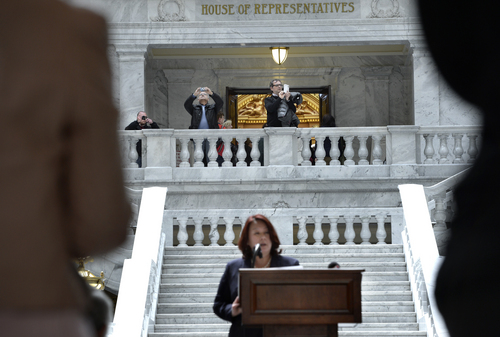This is an archived article that was published on sltrib.com in 2014, and information in the article may be outdated. It is provided only for personal research purposes and may not be reprinted.
A two-day celebration of the indispensable but often ignored role played by Chinese workers in building the transcontinental railroad — completed 145 years ago Saturday — began Friday at Utah's state Capitol.
These workers, more than 11,000 in all, didn't just brave dangerous labor conditions to link the East and West coasts of the United States in 1869, said Margaret Yee, a former state Asian affairs adviser who has railroad workers on both sides of her family tree.
"They opened the door for future generations to be part of this great country," she added before introducing her granddaughter, 9-year-old Ellie Smith from Centerville, to greet a sizable crowd in both English and Chinese.
Many of those present were from 16 local organizations representing various Asian Americans, but there also were visitors from California and New York as well as Chinese journalists.
Most will be part of a delegation that will head early Saturday to Promontory Peninsula northeast of the Great Salt Lake, where the Golden Spike was driven to ceremonially unite the Union Pacific and Central Pacific railroads.
But when the formal photograph of that historic occasion was taken, the Chinese laborers who made it happen — 80 percent of Central Pacific Railroad's workforce was Chinese — were literally out of the picture.
On Saturday, New York City photographer Corky Lee intends to "commit an act of photographic justice" and to re-create that picture, but with descendents of those Chinese laborers in places where their ancestors should have been.
It's his part, he said, in helping them to "reclaim a part of their history long forgotten and neglected."
Friday's festivities focused on the reading of proclamations honoring the Chinese Transcontinental Railroad Commemoration Project by representatives of Utah Gov. Gary Herbert and Salt Lake County Mayor Ben McAdams.
Those recognitions are well deserved, added Attorney General Sean Reyes, citing the "courage and fortitude" of the Chinese workers in "conquering some of the most grueling topography in the West.
"We want those contributions properly recognized," he added, contending similar attitudes among their descendents has "allowed the Chinese community to flourish since then."
Karen Kwan, chairwoman of the Organization of Chinese Americans Utah, said the activities Friday and Saturday are just the start of a campaign to "remember those who have been erased from our history books."
Besides the photo re-enactment and the political tributes, an effort has been launched to include more information in elementary school curricula about the hard work and sacrifices of these Chinese immigrants. They were chosen by the railroads, Kwan said, because they worked "harder, faster and for less money than other ethnic groups."
Oral histories also will be collected from descendants of railroad workers, she added.
Twitter: @sltribmikeg —
More plaudits
The U.S. Department of Labor inducted the collective group of Chinese railroad workers into its Hall of Honor on Friday. The hall recognizes individuals and groups that "have had a profound, positive impact on the American way of work and the American way of life."











